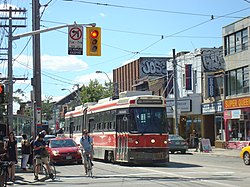- Plans for the "New Town extension" were drafted shortly after York was reincorporated as Toronto, in 1837.
- Store fronts in Niagara, 1928.
- Built in 1852, St. Mary's Church was a Roman Catholic church established to serve Catholic residents in the western portion of the city.
Niagara | |
|---|---|
 Aerial view of Niagara, Toronto in 2025 | |
 Neighbourhood map | |
| Coordinates: 43°38′35″N79°24′29″W / 43.643°N 79.408°W | |
| Country | |
| Province | |
| City | Toronto |
| Government | |
| • City Councillor | Ausma Malik |
| • Federal M.P. | Chi Nguyen |
| • Provincial M.P.P. | Chris Glover |
| Area | |
• Total | 0.549 km2 (0.212 sq mi) |
| Population (2016) [1] | |
• Total | 7,740 |
| • Density | 14,098/km2 (36,510/sq mi) |
Niagara is a neighbourhood in Toronto, Ontario, Canada, located south of Queen Street West; it is usually bordered by Strachan Avenue to the west, Bathurst Street to the east, and the railway corridor to the south, and so named because Niagara Street runs through the centre of it. The eastern portion of this area (with what is now called the Fashion District) was first planned as the New Town Extension when Toronto was incorporated as a city. The area was developed as a residential area for the workers of industries located along the CN and CP railway corridors. It remains a working-class neighbourhood that has seen the development of new condominium apartment buildings.





